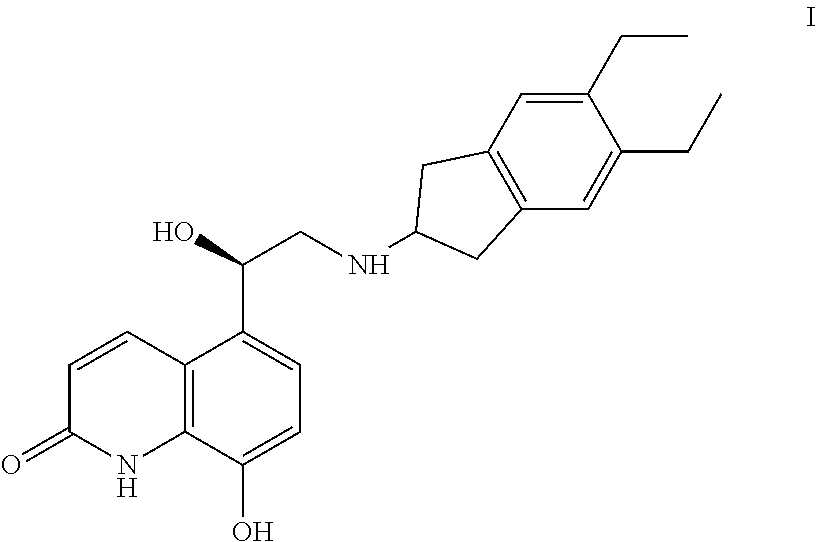Process for preparation of indacaterol or its pharmaceutically acceptable salts
a technology of indacaterol and salt, which is applied in the field of new products, can solve the problems of not being suitable for industrial synthesis, not being suitable for use in chemical instruments and processes, and being expensiv
- Summary
- Abstract
- Description
- Claims
- Application Information
AI Technical Summary
Benefits of technology
Problems solved by technology
Method used
Image
Examples
example
Example 1: Preparation of Compound of Formula III, where L is Bromo
[0094]
[0095]To a mixture of tetrahydrofuran (1400 ml) and Bromo compound (100 g), R-methyl CBS (7.5 g) was slowly added at 25-30° C. under nitrogen atmosphere and cooled to 0-5° C., followed by the addition of Boron Dimethyl Sulfide complex (24.3 g) at 0-10° C. The reaction mass was stirred for 1-2 hr at 0-10° C. The progress of the reaction was monitored by HPLC. After the completion of the reaction, methanol (100 ml) was slowly added to the reaction mass for 30 minutes and stirred for 15 minutes at 0-10° C. The contents were distilled under vacuum at a temperature of 40-45° C. and cooled to 25-30° C. The cooled reaction mixture was slowly added to hydrochloric acid solution at 25-30° C. and stirred for 1-2 hours at the same temperature. The resulted solid was filtered, washed with water (300 ml) and dried at 65-70° C. for 8 hours. % Yield: 95%
example 2
on of Compound of Formula VI, Where A is TBDMS; and L is Bromo
[0096]
[0097]To a mixture of Chloroform (900 ml), the hydroxy bromo compound (100 gm) and Imidazole (72.77 g), TBDMS chloride solution were added at 25-30° C. and refluxed for 10 hours. The progress of the reaction was monitored by HPLC. After the completion of the reaction, the reaction mass was cooled to 15-20° C., washed with 5% HCl solution and distilled under vacuum at 45-50° C. to obtain a residue. The residue was mixed with n-heptane (255 ml) and stirred for 1 hour at 25-30° C. The resultant solid was filtered, washed with n-heptane and dried at 60-65° C. for 5 hours. Yield: 85%
example-3
on of the Compound of Benzyl Indacaterol Maleate
[0098]
[0099]Step-A:
[0100]5,6-Diethyl-2-amino indane (87.14 g) was added to a mixture of 1-methyl pyrrolidone (500 ml) and silyl protected bromo compound (150 g) and heated to 95-100° C. The reaction mixture was maintained for 12 hours at 95-100° C. till the completion of the reaction. The progress of the reaction was monitored by HPLC. The reaction mixture was cooled to 25 to 30° C., followed by the addition of water (300 ml) and ethylacetate (500 ml). The organic layer thus separated and was distilled under vacuum at 50-55° C. to obtain a residue.
[0101]Step-B:
[0102]To the obtained residue in Tetrahydrofuran (500 ml), Tetra-n-butylammonium fluoride (58.05 g) was added and heated to 50-55° C. The reaction mixture was stirred for 6 hours at a temperature of 50-55° C. The progress of the reaction was monitored by HPLC. The reaction mixture was distilled under vacuum at 45-50° C. to get a residue. The obtained residue was dissolved in dilu...
PUM
| Property | Measurement | Unit |
|---|---|---|
| temperature | aaaaa | aaaaa |
| temperature | aaaaa | aaaaa |
| temperature | aaaaa | aaaaa |
Abstract
Description
Claims
Application Information
 Login to View More
Login to View More - R&D
- Intellectual Property
- Life Sciences
- Materials
- Tech Scout
- Unparalleled Data Quality
- Higher Quality Content
- 60% Fewer Hallucinations
Browse by: Latest US Patents, China's latest patents, Technical Efficacy Thesaurus, Application Domain, Technology Topic, Popular Technical Reports.
© 2025 PatSnap. All rights reserved.Legal|Privacy policy|Modern Slavery Act Transparency Statement|Sitemap|About US| Contact US: help@patsnap.com



